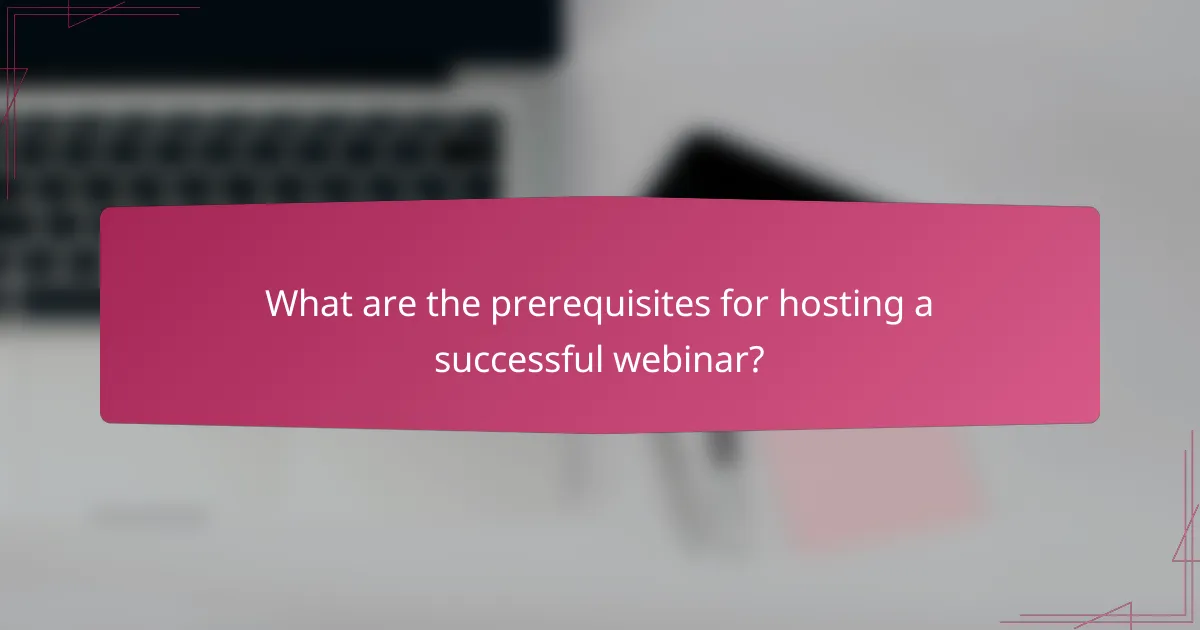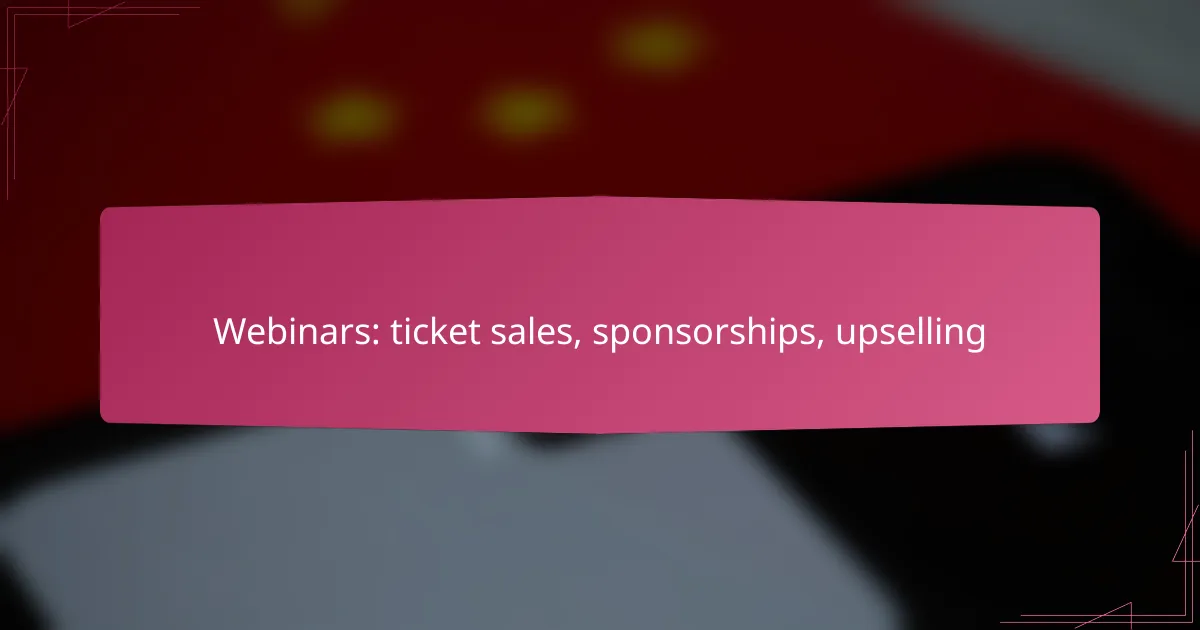Webinars present a unique opportunity to drive ticket sales, attract sponsors, and enhance revenue through upselling. By implementing targeted marketing strategies and optimizing promotional channels, you can significantly increase attendance and revenue. Additionally, effective sponsorship strategies and engaging upselling techniques can create a win-win situation for both sponsors and attendees, enriching the overall experience.

How to increase webinar ticket sales?
To increase webinar ticket sales, focus on targeted marketing strategies, pricing incentives, and optimizing your promotional channels. Implementing these approaches can significantly boost attendance and revenue.
Utilize targeted email marketing
Targeted email marketing is essential for reaching potential attendees who are most likely to be interested in your webinar. Segment your email list based on interests or past attendance to tailor your messaging effectively.
Craft compelling subject lines and include clear calls to action. A/B testing different email formats can help identify what resonates best with your audience.
Leverage social media advertising
Social media advertising allows you to reach a broader audience and target specific demographics. Platforms like Facebook, LinkedIn, and Instagram offer robust advertising tools to promote your webinar effectively.
Consider using eye-catching visuals and engaging content to draw attention. Allocate a budget for ads, and monitor performance metrics to optimize your campaigns over time.
Create early bird pricing incentives
Early bird pricing is a proven strategy to encourage early registrations. Offering discounts for those who purchase tickets ahead of time can create urgency and increase initial sales.
Set a clear deadline for the early bird pricing to motivate potential attendees. A typical range for discounts is 10-30%, depending on your overall pricing strategy.
Implement referral discounts
Referral discounts incentivize current registrants to promote your webinar to their networks. Offering a discount to both the referrer and the new attendee can create a win-win situation.
Clearly communicate how the referral program works and provide easy-to-share links or codes. This can expand your reach significantly without substantial additional marketing costs.
Optimize landing pages for conversions
Your landing page is crucial for converting visitors into ticket buyers. Ensure it is visually appealing, easy to navigate, and contains all necessary information about the webinar.
Include testimonials, speaker bios, and a clear call to action. A/B testing different layouts and content can help identify what leads to higher conversion rates.

What are effective sponsorship strategies for webinars?
Effective sponsorship strategies for webinars involve identifying the right sponsors, creating appealing sponsorship packages, and ensuring sponsors receive visibility throughout the event. These strategies can enhance the overall experience for both sponsors and attendees, leading to successful partnerships.
Identify relevant sponsors in your niche
Finding sponsors that align with your webinar’s topic is crucial. Look for companies that target the same audience or offer complementary products and services. For instance, if your webinar focuses on digital marketing, consider reaching out to software companies or marketing agencies.
Networking within industry groups or attending related events can help you discover potential sponsors. Use platforms like LinkedIn to connect with decision-makers in relevant companies.
Offer tiered sponsorship packages
Creating tiered sponsorship packages allows you to cater to different budgets and levels of engagement. For example, you might offer a basic package that includes logo placement and a mention during the event, while a premium package could include a dedicated segment or a post-webinar follow-up with attendees.
Consider pricing these packages to appeal to a range of sponsors, from startups to established brands. This flexibility can increase your chances of securing sponsorships.
Highlight sponsor benefits during the event
During the webinar, actively promote the sponsors by highlighting their contributions and the benefits they offer. This could include mentioning their products, sharing exclusive offers, or providing a brief introduction to their services.
Engaging the audience with interactive elements, such as polls or Q&A sessions related to the sponsors, can further enhance their visibility and create a more memorable experience for attendees.
Utilize sponsor logos in promotional materials
Incorporating sponsor logos in your promotional materials is essential for visibility. Ensure that logos are prominently displayed on your webinar landing page, email invitations, and social media posts. This not only acknowledges their support but also reinforces their brand to potential customers.
Consider creating a dedicated sponsor section in your webinar slides or handouts, allowing attendees to easily recognize and remember the sponsors after the event.

How to upsell products during webinars?
Upselling during webinars involves strategically promoting additional products or services to attendees, enhancing their experience while increasing revenue. Effective upselling can be achieved through exclusive offers, engaging product demonstrations, and persuasive calls to action.
Showcase exclusive offers for attendees
Presenting exclusive offers during webinars creates a sense of urgency and value for attendees. Consider providing limited-time discounts or bundled packages that are only available to those participating in the session.
For example, if you are hosting a webinar on digital marketing, offer a special rate for a comprehensive marketing toolkit that attendees can purchase at a reduced price. This tactic can significantly boost sales while making attendees feel privileged.
Integrate product demos into the presentation
Incorporating product demonstrations into your webinar can effectively illustrate the benefits of your offerings. Showcasing how a product works in real-time allows attendees to visualize its value and applicability to their needs.
For instance, if you’re promoting software, walk through its features live, highlighting how it solves specific problems. This hands-on approach can lead to higher engagement and increased likelihood of purchases.
Use persuasive call-to-action techniques
Employing strong calls to action (CTAs) is crucial for converting interest into sales. Use clear, direct language that prompts attendees to take immediate action, such as “Buy now to secure your discount!” or “Register today to access exclusive content!”
Additionally, consider placing CTAs at strategic points throughout the webinar, not just at the end. This keeps the offer fresh in attendees’ minds and encourages them to act while they are engaged with your content.

What are the prerequisites for hosting a successful webinar?
To host a successful webinar, you need to ensure you have the right platform, a clear understanding of your objectives, and compelling content. These elements are crucial for engaging your audience and achieving your goals.
Choose the right webinar platform
Selecting the appropriate webinar platform is essential for a smooth experience. Consider factors like user interface, capacity, features, and pricing. Popular options include Zoom, GoToWebinar, and Webex, each offering different functionalities suited for various needs.
Evaluate your audience size and technical requirements. Some platforms support interactive features like polls and Q&A, which can enhance engagement. Ensure the platform you choose can handle your expected number of attendees without technical glitches.
Define clear objectives and audience
Establishing clear objectives helps guide the content and structure of your webinar. Whether your goal is to educate, generate leads, or promote a product, having a defined purpose will keep your presentation focused.
Knowing your target audience is equally important. Research their interests and pain points to tailor your content accordingly. This understanding will help you create a more relevant and engaging experience for your attendees.
Prepare engaging content and visuals
Creating engaging content is vital for maintaining audience interest throughout the webinar. Use storytelling techniques and real-life examples to illustrate your points. Aim for a balance between informative and entertaining material to keep participants engaged.
Visuals play a crucial role in enhancing your presentation. Utilize slides, infographics, and videos to complement your message. Ensure that visuals are clear and professional, avoiding cluttered designs that may distract from your key points.

How to measure the success of a webinar?
Measuring the success of a webinar involves analyzing various metrics that indicate attendance, engagement, and conversion. Key performance indicators (KPIs) such as attendance rates, participant feedback, and sales conversions provide insights into how well the webinar met its objectives.
Track attendance and engagement metrics
To assess attendance, monitor the number of registrants versus actual attendees. A typical attendance rate can range from 30% to 50% of registrants. Engagement metrics, such as chat participation, poll responses, and Q&A interactions, are crucial for understanding participant involvement.
Utilize tools like Google Analytics or webinar platforms that offer built-in analytics to track these metrics. High engagement often correlates with better retention of information and higher chances of conversion.
Analyze post-webinar feedback surveys
Post-webinar surveys are essential for gathering participant feedback on content quality, delivery, and overall experience. Aim for a response rate of at least 20% to ensure the feedback is representative. Questions should focus on what attendees found valuable and areas for improvement.
Consider using a mix of quantitative ratings and open-ended questions to gain comprehensive insights. This feedback can guide future webinars and help refine your content strategy.
Evaluate conversion rates for upsells
Conversion rates for upsells indicate how effectively the webinar prompted attendees to purchase additional products or services. A good conversion rate typically falls between 5% and 15%, depending on the industry and offer. Track these rates by comparing the number of upsell purchases to the total number of attendees.
Implement clear calls-to-action during the webinar and follow up with targeted email campaigns to maximize conversions. Avoid overwhelming participants with too many offers, as this can lead to decision fatigue and lower conversion rates.
